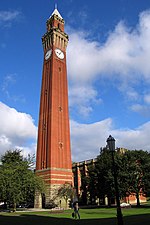Somerset Road railway station
1876 establishments in England1930 disestablishments in EnglandDisused railway stations in Birmingham, West MidlandsEdgbastonFormer Midland Railway stations ... and 6 more
Pages with no open date in Infobox stationRailway stations in Great Britain closed in 1930Railway stations in Great Britain opened in 1876Use British English from December 2016West Midlands (county) building and structure stubsWest Midlands (region) railway station stubs
Somerset Road railway station was a railway station in Edgbaston, Birmingham, England, on the Midland Railway's Birmingham West Suburban Railway. The station had two platforms and was located in a cutting.
Excerpt from the Wikipedia article Somerset Road railway station (License: CC BY-SA 3.0, Authors).Somerset Road railway station
Somerset Road, Birmingham Edgbaston
Geographical coordinates (GPS) Address External links Nearby Places Show on map
Geographical coordinates (GPS)
| Latitude | Longitude |
|---|---|
| N 52.4577 ° | E -1.9283 ° |
Address
Somerset Road
Somerset Road
B15 2RB Birmingham, Edgbaston
England, United Kingdom
Open on Google Maps










